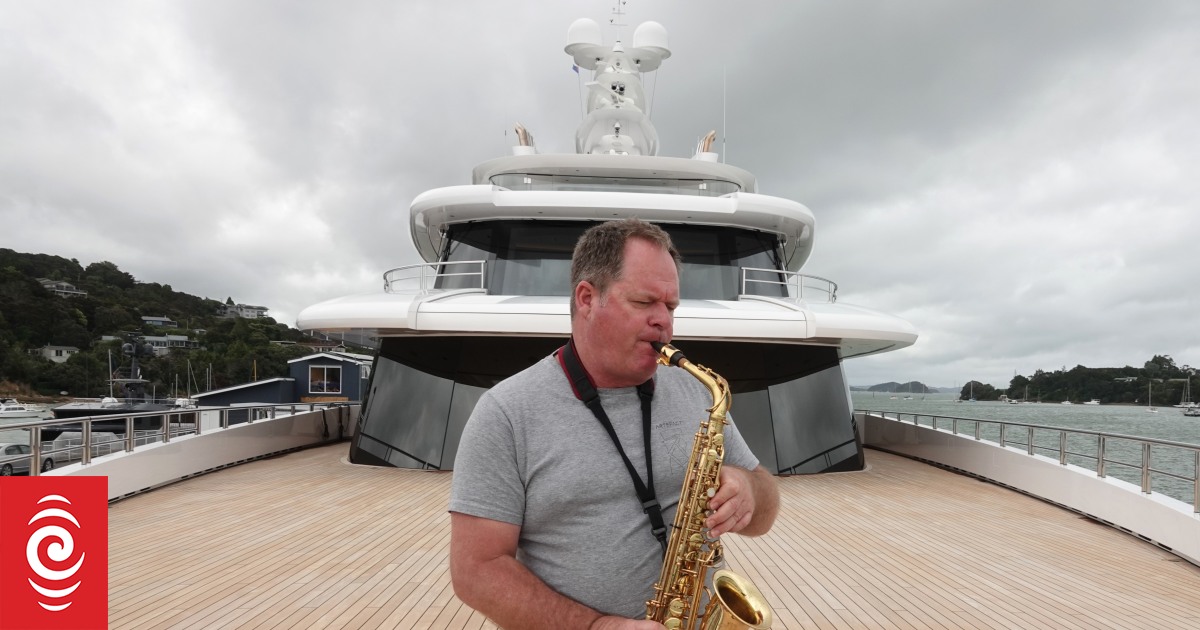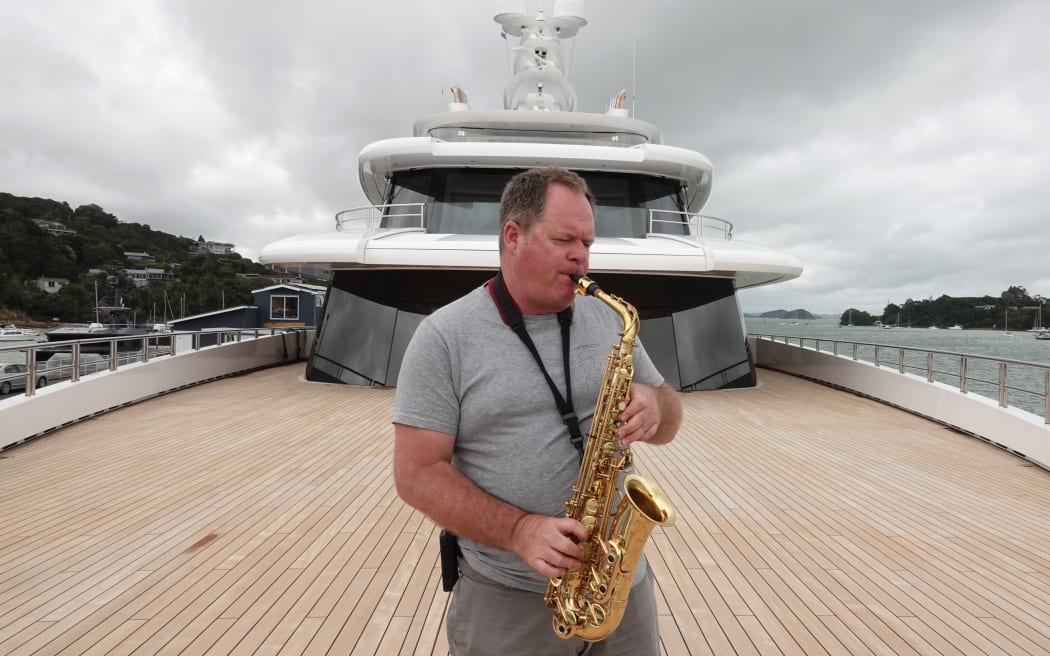
Captain Aaron Clark serenades Opua from Artefact’s foredeck.
Photo: RNZ / Peter de Graaf
It was quite a homecoming for the “boat-mad” boy who grew up sailing Optimists and left school aged 15 to become a commercial fisherman.
When Aaron Clark arrived in the Northland port of Ōpua just before Christmas, it was as the captain of one of the world’s most exclusive superyachts.
Built in 2020 with a price tag believed to be well north of US$150 million (NZ$240m), the 80-metre Artefact was named motor yacht of the year in the 2021 World Superyacht Awards.
The ship set new records for internal volume and the sheer amount of glass used in a vessel of its size.
The hybrid diesel-electric motor yacht was also the first to be built with a so-called DC-bus power system, making its significantly more efficient than traditionally powered vessels.
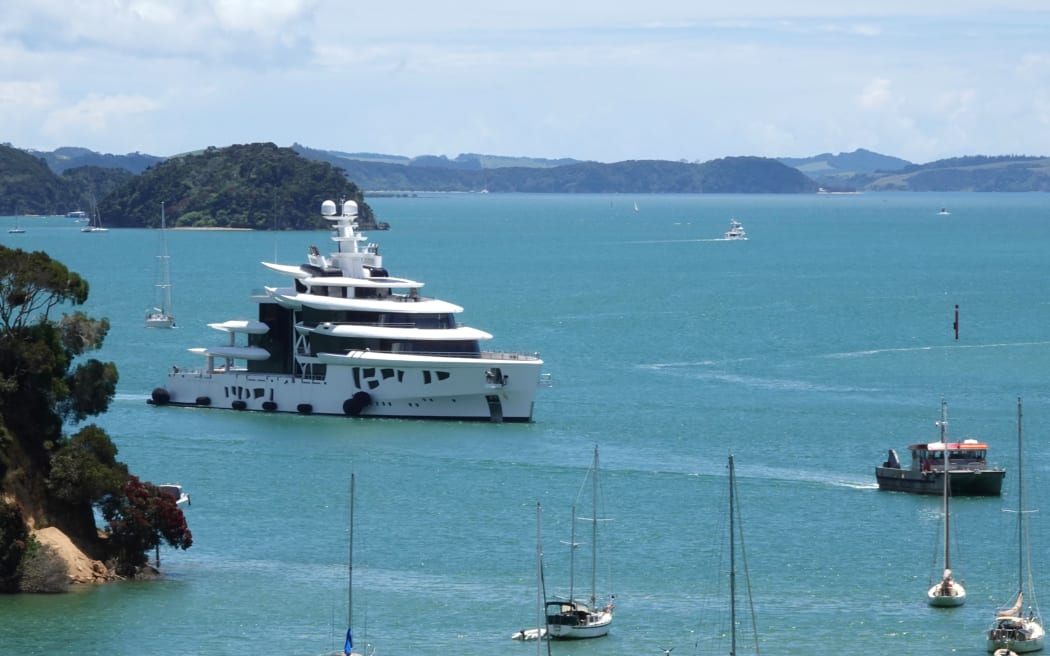
The 80-metre superyacht Artefact is escorted to Ōpua wharf by the harbourmaster’s vessel Waikare.
Photo: RNZ / Peter De Graaf
And for Clark, it is also home as he sails the globe for up to nine months of the year.
There are just two things the ebullient Captain Clark won’t discuss: one is how much the boat cost, the other is its owner.
The US$150m estimate comes from industry experts, but it’s based on the price of an 80-metre production vessel.
Artefact is a one-of-a-kind, custom-built boat so the actual cost is likely to be much higher.

Captain Aaron Clark in the ship’s engine room.
Photo: RNZ / Peter de Graaf
And while Clark won’t discuss the owner – other than to say he’s an “exceptional person to work for” who has contributed much to society – it is Canadian tech entrepreneur Mike Lazaridis, as previously reported by RNZ.
Lazaridis is best known for creating the BlackBerry mobile device but these days he specialises in quantum computing.
The 62-year-old was described as the father of the smartphone when he was nominated as a Fellow of the Royal Society, Britain’s prestigious national sciences academy, in 2014.
Lazaridis was born in Turkey to Greek parents, who moved to Canada when he was a child.
There he quickly excelled in science, even winning an award as a 12-year-old for reading every scientific book in his hometown’s library.
While Clark won’t talk about his boss, he is more than happy to discuss Artefact’s extraordinary specifications.
The ship is designed for 12 passengers and 22 crew, with a beam of 15.6m and a draft of 4.2m.
It has a gross tonnage (a measure of volume) of 2999 and a range of about 6000 nautical miles or 11,000km.
Its four generators – two each of 2.2MW and 550kW – and a 610kWh battery bank provide power to two 27-tonne pod-mounted drive units, as well as a bow thruster for manoeuvring in tight spaces and a host of on-board systems including a 60-tonne-a-day desalinator.
A solar panel array provides enough power for lighting.

Even superyachts need to get Customs clearance.
Photo: RNZ / Peter De Graaf
Like a hybrid car, Clark says Artefact can run entirely on its battery for limited distances, but what makes it stand out technically is its DC-bus power system.
“That means the engine will deliver only the required amount of power at any given time and we buffer that with a battery. So we can run it in full battery mode with no internal combustion engines, or we use it for more efficient use of the generator,” he says.
From the outside Artefact’s most distinctive feature is its foam-cored fibreglass superstructure, chosen for its light weight and because it allowed the designers to create curving, organic shapes.
The vessel’s 223 pieces of glass are up to 93mm thick, weigh 75 tonnes and cover an area of 760 square metres.
“When we built this boat, the largest superyacht in the world was about four times bigger by volume but Artefact had 30 percent more glass. That gives you an idea of how much glass it’s got.”
The interior boasts a dedicated tai chi room, a craft room, a cinema, and separate gyms for the owners and staff.
It’s a long way from Clark’s humble start in boating.
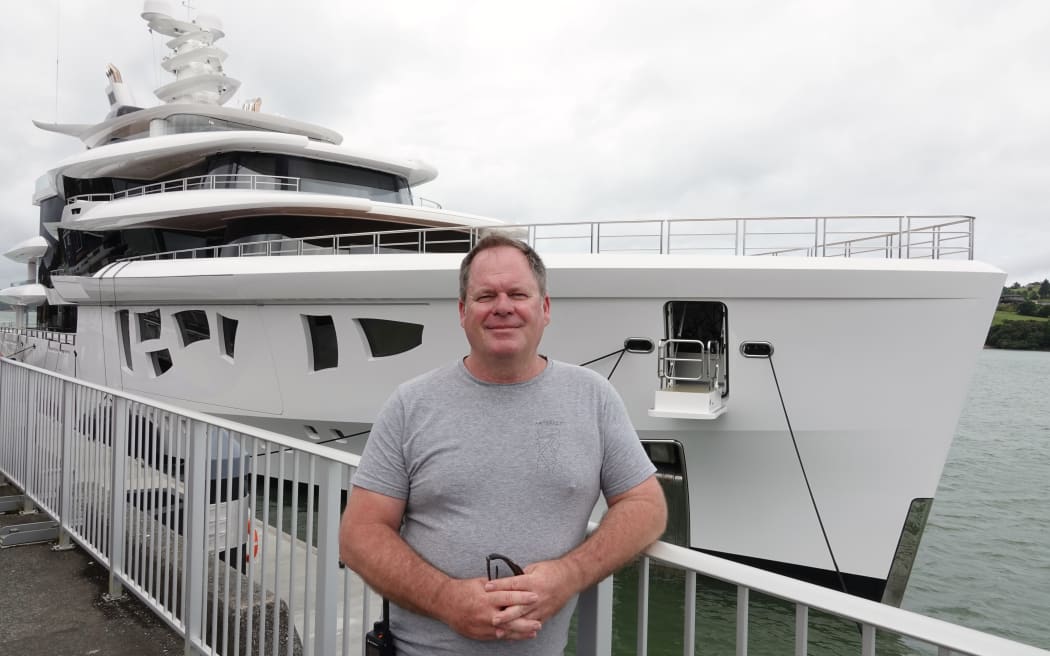
Captain Aaron Clark with Artefact at Ōpua wharf.
Photo: RNZ / Peter de Graaf
The 52-year-old grew up in Beachlands, then a coastal village southeast of Auckland, where his father was a commercial fisherman.
“And because it was a little coastal town, I was totally boat mad. I sailed Optimists and P-class boats, I’d draw boats, I built papier-mâché models. Boats, boats, boats. I worked fishing with my dad and whenever I could get a good school holiday break, I’d work at the local boatbuilding yard. And eventually when I went to leave school, at the age of 15, I got a boatbuilding apprenticeship.”
However, Clark soon discovered the job wasn’t for him.
Instead, he took up commercial fishing – first with his father and later from the Far North ports of Mangōnui and Houhora – before landing work in Auckland with a sail excursion business and driving high-speed ferries.
He then built a boat at Austral Yachts in Whangārei, eventually taking it to the Mediterranean as a charter vessel.
There he met an American family who asked him to design and built a 45-metre boat. Clark worked for them for the next 14 years.
“We did a lot of mileage and really did well with it. It was a very successful charter boat.”
One of those charter guests was so impressed he asked Clark if he would build him an out-of-the-ordinary boat.
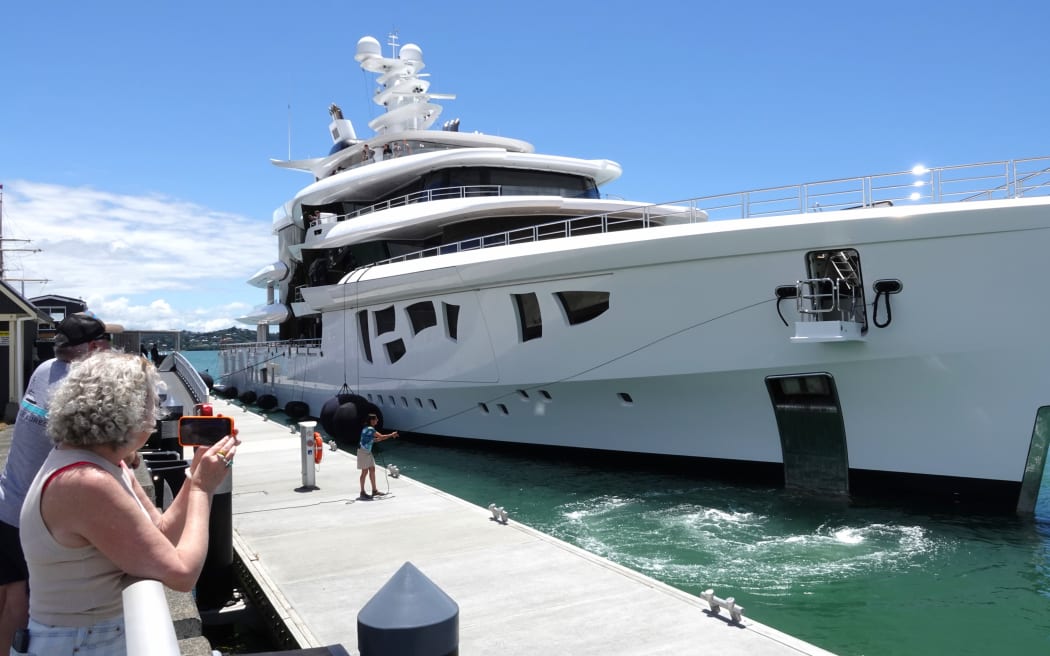
The 80-metre superyacht Artefact berths at Ōpua wharf.
Photo: RNZ / Peter De Graaf
Clark accepted the challenge and was put in charge of every aspect of technical design.
His advice to his new boss was to build it well, with technology that could be replaced and updated, so it would last a good 30 years.
“My advice was to future-proof the boat and build it bigger than you think you want it, so in the future, you don’t grow out of it and need to build a larger boat. Take your time to do it. Make it your first boat and your last boat, so you never have to change.”
Clark says 80,000 man-hours went into the design process before the builders cut a single piece of metal.
He had life-size interior mock-ups built, carried out tank tests, and caught 82 flights in a year visiting manufacturers around the world.
The boat was built at the famed German shipyard Nobiskrug.
“They’re a shipyard that truly does one-off boats. They build some spectacular yachts that other people probably wouldn’t even try to build because it’d be outside their business model. Also, this was the first boat of its type in the industry, with a DC-bus power system, so we needed to go to a company that could manage the electrical contracting companies really well.”
In total 1000 people were involved in building the vessel over a two-and-a-half-year period. He estimates 72,000 people came into contact with money from the project.
Clark says he wanted to bring Artefact to Ōpua because it’s “the boatie base of Northland”.
The spot where he berthed the ship also happens to be exactly 203 metres – he knows, because he measured it – from the driveway of his home.
“I wanted to bring it here because of the history, I had some time in the schedule, and there’s a whole lot of people from New Zealand that have supplied stuff to the boat. So it’ll give a lot of people inspiration to see the work that they’ve done. After the last few difficult years for everyone, we want to show people we’re moving again, and create some excitement. I also just want to share it with my neighbours and some friends, and with business people in the community.”
New Zealand-built equipment on Artefact includes a Sealegs amphibious boat and a guest tender, which doubles as a game fishing boat, built by Lloyd Stevenson Boatbuilders in Auckland.
The stern anchor system was designed and built by Manson Anchor in Auckland, and the 48 fishing rods and other fishing gear were supplied by Kiwi firm Burnsco.
Artefact sailed to Picton after a 10-day stay at Ōpua and will next head to Auckland for servicing and maintenance.
The vessel will spend the rest of the summer cruising around Northland.
Clark has no doubt his New Zealand upbringing aided his journey from boat-mad boy to superyacht captain.
“I’d say the New Zealand attributes that have helped are the love of adventure, the isolation, the ability to be independent and fix your own stuff. Those are definitely things from New Zealand that I’ve taken overseas which have probably given me a bit of an edge. I think Kiwis generally have a pretty good attitude about how to go about things, and do it in a kind of low-key way.”
A personal attribute he believes has helped is “the ability to see a shoreline not as a border, but as something to explore”.
As for Clark’s message to boat-mad young Kiwis hoping to follow in his wake: “Just get more boat-mad. Don’t limit yourself or your imagination. Think about it, plan it out, go do it. Make some mistakes but just keep on doing it until you get it right. And have a lot of fun.”

